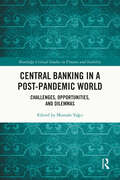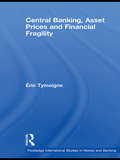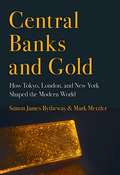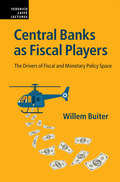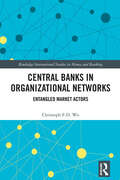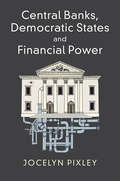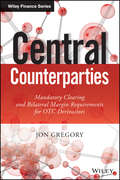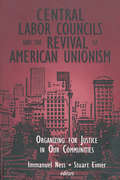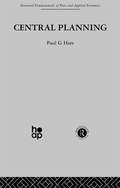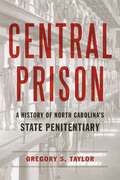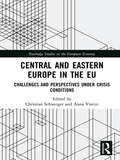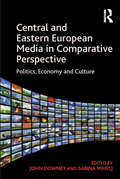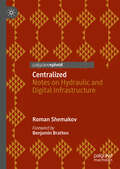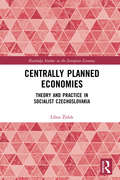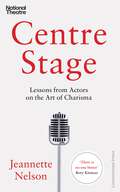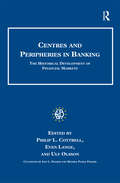- Table View
- List View
Central Banking in a Post-Pandemic World: Challenges, Opportunities, and Dilemmas (Routledge Critical Studies in Finance and Stability)
by Mustafa YağciThis book addresses the urgent need to examine central bank policies in response to the global supply and demand shock brought on by the Covid-19 pandemic, asking whether central banks are doing enough to address inequalities and concerns around climate change and emerging technologies. Adopting an interdisciplinary, critical perspective, the contributors to this volume provide novel theoretical, methodological, and empirical insights on central banks around the world, including in advanced, emerging and developing economies. The chapters in this book explore the evolution of central bank mandates, the policy tools central banks are utilizing, why and how monetary policy takes different shapes (including unconventional monetary policy), the key dynamics influencing central bank policies, how central banks are adapting to the new realities and addressing emerging challenges, and how monetary policy is perceived in the wider economic policy framework. With novel theoretical approaches and diverse empirical evidence from a variety of countries, this book will appeal to readers interested in central banking, monetary policy, the economics of the pandemic and political economy.
Central Banking in the Twentieth Century
by John SingletonCentral banks are powerful but poorly understood organisations. In 1900 the Bank of Japan was the only central bank to exist outside Europe but over the past century central banking has proliferated. John Singleton here explains how central banks and the profession of central banking have evolved and spread across the globe during this period. He shows that the central banking world has experienced two revolutions in thinking and practice, the first after the depression of the early 1930s, and the second in response to the high inflation of the 1970s and 1980s. In addition, the central banking profession has changed radically. In 1900 the professional central banker was a specialised type of banker, whereas today he or she must also be a sophisticated economist and a public official. Understanding these changes is essential to explaining the role of central banks during the recent global financial crisis.
Central Banking, Asset Prices and Financial Fragility (Routledge International Studies in Money and Banking)
by Éric TymoigneThe current literature on central banking contains two distinct branches. On the one side, research focuses on the impact of monetary policy on economic growth, unemployment, and output-price inflation, while ignoring financial aspects. On the other side, some scholars leave aside macroeconomics in order to study the narrow, but crucial, subjects of financial behaviours, and financial supervision and regulation. This book aims at merging both approaches by using macroeconomic analysis to show that financial considerations should be the main preoccupation of central banks. Eric Tymoigne shows how different views regarding the conception of asset pricing lead to different positions regarding the appropriate role of a central bank in the economy. In addition, Hyman P. Minsky’s framework of analysis is used extensively and is combined with other elements of the Post Keynesian framework to study the role of a central bank. Tymoigne argues that central banks should be included in a broad policy strategy that aims at achieving stable full employment. Their sole goal should be to promote financial stability, which is the best way they can contribute to price stability and full employment. Central banks should stop moving their policy rate frequently and widely because that creates inflation, speculation, and economic instability. Instead, Tymoigne considers a pro-active financial policy that does not allow financial innovations to enter the economy until they are certified to be safe and that focuses on analyzing systemic risk. He argues that central banks should be a guide and a reformer that allow a smooth financing and funding of asset positions, while making sure that financial fragility does not increase drastically over a period of expansion. This book will be of interest to students and researchers engaged with central banking, macroeconomics, asset pricing and monetary economics.
Central Banks and Coded Language
by Elke MuchlinskiThis book explores implications of the modern view of central banks rising from the proposition that words have no meaning beyond their use in a particular context and setting. It studies coded language to explain why a central bank's decisions and communicative interactions can't be devoted to a coded language which is an artificial language.
Central Banks and Gold: How Tokyo, London, and New York Shaped the Modern World (Cornell Studies in Money)
by Mark Metzler Simon James BythewayIn recent decades, Tokyo, London, and New York have been the sites of credit bubbles of historically unprecedented magnitude. Central bankers have enjoyed almost unparalleled power and autonomy. They have cooperated to construct and preserve towering structures of debt, reshaping relations of power and ownership around the world. In Central Banks and Gold, Simon James Bytheway and Mark Metzler explore how this financialized form of globalism first took shape a century ago, when Tokyo first joined London and New York as a major financial center.As revealed here for the first time, close cooperation between central banks began along an unexpected axis, between London and Tokyo, around the year 1900, with the Bank of England's secret use of large Bank of Japan funds to intervene in the London markets. Central-bank cooperation became multilateral during World War I—the moment when Japan first emerged as a creditor country. In 1919 and 1920, as Japan, Great Britain, and the United States adopted deflation policies, the results of cooperation were realized in the world’s first globally coordinated program of monetary policy. It was also in 1920 that Wall Street bankers moved to establish closer ties with Tokyo. Bytheway and Metzler tell the story of how the first age of central-bank power and pride ended in the disaster of the Great Depression, when a rush for gold brought the system crashing down. In all of this, we see also the quiet but surprisingly central place of Japan. We see it again today, in the way that Japan has unwillingly led the world into a new age of post-bubble economics.
Central Banks as Fiscal Players: The Drivers of Fiscal and Monetary Policy Space (Federico Caffè Lectures)
by Willem BuiterIt is well known that the balance sheets of most major central banks significantly expanded in the aftermath of the financial crisis of 2007-2011, but the consequences of this expansion are not well understood. This book develops a unified framework to explain how and why central bank balance sheets have expanded and what this shift means for fiscal and monetary policy. Buiter addresses a number of key issues in monetary economics and public finance, including how helicopter money works, when modern monetary theory makes sense, why the Eurosystem has a potentially fatal design flaw, why the fiscal theory of the price level is a fallacy and how to escape from the zero lower bound.
Central Banks in Organizational Networks: Entangled Market Actors (Routledge International Studies in Money and Banking)
by Christoph F-D. WuThis inter-disciplinary and wide-ranging study unravels the social processes of decision-making at the interface of central banks and financial market participants, and thereby raises important questions about responsible central bank governance and its obligations to stakeholders in society. The book challenges commonly held assumptions on how central banking works and critically assesses unconventional monetary policy and its underlying theoretical tenets. Drawing from rich, multi-sited fieldwork and data collection, this research monograph offers an in-depth look into the financial market practices around the quantitative easing programmes of the European Central Bank and focuses on the uneasy role of modern central banks as active market participants. The author introduces concepts from social network theory and develops a novel method to study organisational networks in the context of financial markets. An analysis of the European Central Bank’s social, organisational and financial networks is sketched over the course of multiple chapters. The concluding chapters dive into documentary analysis and the extensive material from qualitative interviews with senior investment professionals about the strategies and adaptive processes around the lived experience of quantitative easing. The book will be a vital resource for social scientists researching organisations in financial markets, providing theory, concepts, empirical data and practical implications. It will be of interest to academics and graduate students in economics, sociology and management/organisation studies, as well as practitioners at central banks and in asset management.
Central Banks, Democratic States and Financial Power
by Jocelyn PixleyWhen the Federal Reserve, European Central Bank and Bank of England purchased bank and state debt during the 2007–2008 crisis, it became apparent that, when technically divorced from fiscal policy, monetary policy cannot revive but only prevent economic activity deteriorating further. Pixley explains how conflicting social forces shape the diverse, complex relations of central banks to the money production of democracies and the immense money creation by capitalist banking. Central banks are never politically neutral and, despite unfair demands, are unable to prevent collapses to debt deflation or credit/asset inflation. They can produce debilitating depressions but not the recoveries desired in democracies and unwanted by capitalist banks or war finance logics. Drawing on economic sociology and economic histories, this book will appeal to informed readers interested in studying democracies, banks and central banking's ambivalent positions, via comparative and distributive perspectives.
Central Counterparties
by Jon GregoryThe Global Financial Crisis, from 2007 onwards, illustrated the inherent weaknesses in the global financial system and some of their causes. In particular over-the-counter (OTC) derivatives were blamed by many for partially causing and catalysing the crisis. Not surprisingly, this has led to dramatic action from politicians, policymakers and regulators in relation to OTC derivative markets. Two of the most important changes are the mandatory clearing of standardised OTC derivatives and the requirements for bilateral margin posting in non-standard OTC contracts. Both clearing and margining mandates will be effectively phased in from 2014 and the associated costs will be severe. These regulatory changes are therefore going to create a dramatic shift in the topology of financial markets, together with a significant reallocation of counterparty and systemic risks. Knowledge of the subject is an important consideration for all financial institutions whether they are CCP members, clear trades indirectly or find themselves subject to bilateral margin requirements. Central Counterparties: Mandatory Clearing and Bilateral Margin Requirements for OTC Derivatives explains the central clearing of OTC derivatives and the associated bilateral margin requirements. The book provides a historical perspective of central clearing as it developed with derivative exchanges in order to mitigate counterparty credit risk. The regulatory requirements (Dodd-Frank, EMIR, Basel III) being imposed since the global financial crisis are defined and discussed. The mechanics of central clearing are described including operational aspects, initial margin and default fund calculations, loss waterfalls and allocation methods. Client clearing is discussed, in particular giving detail on margin segregation and portability methods. An assessment is made throughout of the advantages and disadvantages of clearing and margining requirements, including potential issues such as funding liquidity risk, operational risk and wrong-way risk. The book is unique and covers the regulatory requirements together with the practical implementation details and the potential impacts and consequences. It is an invaluable and complete reference guide for any market practitioner, policy maker, academic or student with responsibility or interest in the area of OTC derivatives.
Central European Distribution Corporation: Hostile Takeover, Bankruptcy Makeover
by Stuart C. Gilson Sarah L. AbbottIn early 2013, CEDC, a large publicly-traded producer and distributer of vodka and spirits in Eastern and Central Europe, has suffered significant declines in its financial performance, is at risk of defaulting on its debt, and is under pressure from its largest shareholders to give them control of the board and to restructure its debt to avoid bankruptcy. The largest shareholder, billionaire Russian investor Roustam Tariko, has proposed an out of court exchange offer for CEDC's publicly traded bonds and investment in CEDC's stock that would give him full ownership of the company. If the exchange offer fails, the company will file for prepackaged Chapter 11 bankruptcy in the United States.
Central European Distribution Corporation: Hostile Takeover, Bankruptcy Makeover
by Stuart C. Gilson Sarah L. AbbottIn early 2013, CEDC, a large publicly-traded producer and distributer of vodka and spirits in Eastern and Central Europe, has suffered significant declines in its financial performance, is at risk of defaulting on its debt, and is under pressure from its largest shareholders to give them control of the board and to restructure its debt to avoid bankruptcy. The largest shareholder, billionaire Russian investor Roustam Tariko, has proposed an out of court exchange offer for CEDC's publicly traded bonds and investment in CEDC's stock that would give him full ownership of the company. If the exchange offer fails, the company will file for prepackaged Chapter 11 bankruptcy in the United States.
Central Georgia Textile Mills (Images of America)
by Billie ColemanCotton was once king throughout Georgia. Reconstruction investors and railroad tycoons saw this potential to open textile mills in the South instead of sending cotton up North. Towns across Central Georgia became a prime spot to locate textile mills because of the access to cotton from local farms, cheap labor, and nearby rivers to power the mills. Textile mills were operated in cities and towns across Central Georgia such as Macon, Columbus, Augusta, Tifton, Forsyth, Porterdale, and Hawkinsville, among others. The textile mills provided employment and sometimes a home in their villages to people across Georgia as the agrarian lifestyle gave way to industrial expansion. In these mills, photographer Lewis Hine captured iconic images of child labor. After the decline of production and closing of the mills, many have been revived into new usages that honor the legacy of the mill workers and their families who lived in the villages of the textile mills across Central Georgia.
Central Labor Councils and the Revival of American Unionism: Organizing for Justice in Our Communities
by Immanuel Ness Stuart EimerCentral Labor Councils are the local arm of the labor movement responsible for coordinating collective activities among different unions in a region. Once quite powerful organizations with important political roles at local and regional levels, CLCs waned significantly during the 1940s and 50s.This work examines the recent re-emergence of Central Labor Councils and how they are being utilized as effective bodies to help rejuvenate the labor movement. It combines comprehensive history of the CLCs in America since the early 19th century and case studies by CLC leaders in Atlanta, Milwaukee, San Jose, and Seattle -- the regions where CLCs have re-emerged as important players in advancing the labor movement.
Central Planning (Fundamentals Of Pure And Applied Economics Ser.)
by P. HareExamines the nature and the mode of operation of the centrally planned economy, assessing its strengths and the weaknesses that eventually led to its demise.
Central Prison: A History of North Carolina’s State Penitentiary
by Gregory S. TaylorGregory S. Taylor’s Central Prison is the first scholarly study to explore the prison’s entire history, from its origins in the 1870s to its status in the first decades of the twenty-first century. Taylor addresses numerous features of the state’s vast prison system, including chain gangs, convict leasing, executions, and the nearby Women’s Prison, to describe better the vagaries of living behind bars in the state’s largest penitentiary. He incorporates vital elements of the state’s history into his analysis to draw clear parallels between the changes occurring in free society and those affecting Central Prison. Throughout, Taylor illustrates that the prison, like the state itself, struggled with issues of race, gender, sectionalism, political infighting, finances, and progressive reform. Finally, Taylor also explores the evolution of penal reform, focusing on the politicians who set prison policy, the officials who administered it, and the untold number of African American inmates who endured incarceration in a state notorious for racial strife and injustice. Central Prison approaches the development of the penal system in North Carolina from a myriad of perspectives, offering a range of insights into the workings of the state penitentiary. It will appeal not only to scholars of criminal justice but also to historians searching for new ways to understand the history of the Tar Heel State and general readers wanting to know more about one of North Carolina’s most influential—and infamous—institutions.
Central and Eastern Europe Roads to Growth
by Georg WincklerA report from the International Monetary Fund.
Central and Eastern Europe and the CIS
by Jerome WittLearn about the many economical and political changes in Central and Eastern Europe to stay on top of business!Western academics are being called upon to play a principle role in the redefinition of management education in Central and Eastern Europe and the former USSR. Among the countless ideological, political, and economic issues engendered by the demise of communism throughout the region, myriad challenges in business education have surfaced. Central and Eastern Europe and the CIS provides an insightful background for Western educators who wish to play a part in or simply bear witness to this historic development.This book reveals and documents some of the major educational efforts and issues which have emerged during the past few years and relates the experiences and viewpoints of some of the most active participants. It shares both insights and lessons that have already been learned with those who seek to contribute in the future. Each chapter will interest and challenge the reader as it frankly describes the struggle to establish modern business education in these dynamic societies.In this collection, distinguished contributors counsel readers that if Western educators are to make an effective contribution, they must first discover which western ideas and theories can be used immediately, which need to be adapted to fit the local environments, and which must be completely rethought. Each chapter enhances the understanding of business education in these emerging societies and affords a clearer understanding of the gulf between East and West.Topics in Central and Eastern Europe and the CIS include: international business education in Estonia-from socialism to capitalism business education and management training in the old and new East Central Europe the International Center for Public Enterprises in Slovenia-implications for teaching interpersonal skills and introducing international business concepts teaching organization behavior to Eastern European managers-a process of adaptation to change Business education will most certainly have a significant impact on the restructuring of the political and social cultures in the region and is, in fact, critical to the ultimate success of democratic free market systems. Central and Eastern Europe and the CIS helps Western educators and practitioners alike to make a useful contribution toward meeting the opportunities and threats in this historic era.
Central and Eastern Europe in the EU: Challenges and Perspectives Under Crisis Conditions (Routledge Studies in the European Economy)
by Anna Visvizi Christian SchweigerSince the onset of the global financial crisis in 2008, the EU has been in almost permanent crisis mode. It is witnessing new dimensions of internal differentiation among its member states, and the migration crisis has shown that the Central and Eastern European countries (CEEs) in particular are slowly but certainly transforming themselves from predominantly passive policy-takers towards becoming more active players in the process of shaping the EU’s governance agenda. This edited volume offers the first comprehensive and critical insight into how the CEEs position themselves in the EU’s changing internal and external environment, their stance towards the European integration process under current crisis conditions, and what political and economic strategies they prioritize.
Central and Eastern European Attitudes in the Face of Union
by Simona GuerraThrough the analysis of data on support for and opposition to European integration in Central and Eastern Europe, this book explores how and why support for the EU has changed in this region and the factors that have led to the fall in popularity of the EU as an institution.
Central and Eastern European Media in Comparative Perspective: Politics, Economy and Culture
by Sabina MiheljAppearing more than twenty years after the revolutions in Central and Eastern Europe, this book could not have come at a more appropriate time; a time to take stock not only of the changes but also the continuities in media systems of the region since 1989. To what extent are media institutions still controlled by political forces? To what extent are media markets operating in Central and Eastern Europe? Do media systems in Central and Eastern Europe resemble media systems in other parts of Europe? The answers to these questions are not the same for each country in the region. Their experience is not homogeneous. An international line up of distinguished experts and emerging scholars methodically examine the different economic, political, cultural, and transnational factors affecting developments in media systems across Central and Eastern Europe. Whereas earlier works in the media system tradition have, in the main, adopted the political framework of comparative politics, the authors argue that media systems are also cultural and economic institutions and there are other critical variables that might explain certain outcomes better. Topics discussed range from political economy to gender inequality to the study of ethno-cultural diversity. This unmatched volume gives you the unique opportunity to study the growing field of comparative media analysis across Eastern and Western Europe. A valuable resource that goes beyond the field of media and cultural analysis which media scholars as well as to area specialists should not go without!
Centralized: Notes on Hydraulic and Digital Infrastructure
by Roman ShemakovAn estimated 75% of the infrastructure that societies will depend on in 2050 does not yet exist, reflecting $139 trillion of investment over the next quarter century. Conventional wisdom regards these forthcoming water networks, roads, energy grids, and data centers as passive backbones of economic life. Centralized challenges this assumption, demonstrating how these systems actively shapes governance by regulating the flow of materials, managing access, and controlling storage. Centralized examines the oldest and the most contemporary forms of large-scale infrastructure: water and the internet. Drawing on archival documents, engineering blueprints, financial records, and interviews, the book analyzes eight transformative projects over two millennia across the United States, China, Turkey, and Russia. From the Dujiangyan irrigation canals to the creation of TCP/IP protocols, the case studies demonstrate how engineering networks produce predictable bureaucratic structures. Despite their technological differences, hydraulic and digital networks share a unifying logic of design, finance, and administration—one that ultimately consolidates authority. Built on the work of Keller Easterling, Norbert Wiener, Taisu Zhang, and Paul Edwards, Centralized offers a critical historical perspective on the relationship between technical and social systems. Preface by Benjamin Bratton. Illustrations by Flora Weil.
Centrally Planned Economies: Theory and Practice in Socialist Czechoslovakia (Routledge Studies in the European Economy)
by Libor ŽídekOffering a retrospective view of how the system operated in Communist Czechoslovakia, this book is an important voice in the discussion about the systems of central planning. The unique features of the book include in-depth research comprising both archival records and analyses of around 75 interviews conducted with period managers across a wide range of management levels. They provided evidence of pervasive inefficiency resulting in appalling economic outcomes. The book begins with a background to the politico-sociological system in Czechoslovakia and proceeds to describe the Marxist-Leninist ideological foundation of the regime, which underpinned the formal setting of the Czechoslovak model. These initial chapters set the context for the subsequent analysis of the real functioning of the system. The book explores the economic outcomes that must be understood as a natural consequence of the ways in which this system operated. The author finishes by answering the important question of why centrally planned economies trailed behind the market economies. The book’s unique use of the interview research format brings a vivid, close-up view of the everyday economic life in the centrally planned system. This will be a valuable contribution to the discussion surrounding the day-to-day reality of the system, which was found to be more colourful than is generally deemed. The book will appeal to both economic historians and students of economic history. A warning against repeating past mistakes, this book will also be of interest to those seeking a greater knowledge of the realities and consequences of centrally planned economies.
Centre Stage: Lessons from Actors on the Art of Charisma
by Jeannette NelsonHow the world’s best actors communicate with gravitas – and how you can, too.‘The theatre stars’ voice guru’ Daily MailActing is all about charisma. Whether you’re an A-list star or an extra, when you’re on stage you need to perform in a way that makes your audience listen.That stage presence is something we can all learn from. Every time you speak up in a meeting, recount an anecdote, or tell a joke, it’s essential to communicate with gravitas.Jeannette Nelson knows a thing or two about gravitas. As Head of Voice at the National Theatre, she has spent three decades working with the world’s leading actors – from Al Pacino to Benedict Cumberbatch to Juliette Binoche – teaching them to speak clearly and move confidently.Now, Nelson pulls back the curtain on the tricks that professional performers use to own the room. Starting with clear speech and good posture, before moving on to the art of rhetoric and overcoming stage fright, she outlines a holistic three-stage method to communicating with authority, authenticity and eloquence. Throughout, she peppers the book with stories of how world-renowned actors learnt to make themselves heard – and how you can, too.The result is a fascinating and eminently practical guide to the art of performance. If all the world’s a stage, then this book will turn you into its lead actor.
Centres and Peripheries in Banking: The Historical Development of Financial Markets (Studies in Banking and Financial History)
by Iain L. Fraser Even Lange Ulf OlssonThis volume presents a broad investigation into the relationship between the centre and the periphery in banking. Focusing on the historical development of financial markets, from their emergence in the early modern period to today's global financial and capital markets, the chapters investigate how local, national and international relationships have affected and helped shape the banking industry over three-hundred years. This wide-ranging discussion in time and place is provided by a group of international experts, encompassing bankers, economists, economic historians and historians, and will be of interest to all those with a scholarly or professional interest in the development of financial institutions.
Cents & Sensibility
by Scott Palmer Bethany PalmerConflicts about money are often the key source of arguments between couples. That's because most of the time, spouses look at financial matters very differently. One might be a "saver" while the other is a "spender." But neither type is necessarily "right" in the way they choose to handle family funds.This is a guidebook to help married and engaged couples build (or rebuild) their relationship by working together on financial issues. With God's principles at work, there is hope for arriving at financial balance! Couples learn to understand and respect each other, and by communicating more effectively, can begin the journey to financial harmony--and joy!
